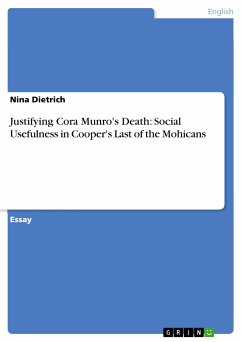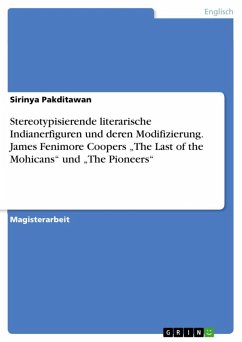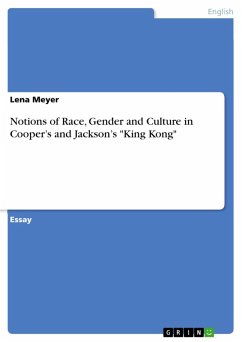Essay from the year 2002 in the subject American Studies - Literature, grade: 1.0 (A), University of Kent (School of English), course: 19th-Century American Literature, language: English, abstract: In James Fenimore Cooper's fiction, 'women are of central social significance. [Cooper's] theme is society, and he defines women as the nexus of social interaction,' Nina Baym argues1. She claims that the author is not interested in women's personhood or individuality, but rather in their usefulness for society. According to Baym, matrimony is 'the chief "statement" of the social language'.2 Therefore, if a woman is apt for marriage, she is socially utile. One of the main aspects of The Last of the Mohicans is the dichotomy between the half-sisters Cora and Alice Munro, to whom the concept of social usefulness can be applied. On the one hand, Fenimore Cooper presents Alice, who is fair, helpless and infant ile, as marriageable. On other hand, Cora, the dark, courageous and initiated sister, is considered unsuitable for wifehood. Instead of letting Cora be united in marriage with the Indian Uncas in the end of the novel, the author decides to kill both of the m. Many of his contemporaries have urged Cooper to change the unhappy ending. One critic, for instance, writes: Every event as we go along points to a favourable termination, when just at the winding up, the design seems to be capriciously reversed, and [Cora and Uncas] are most summarily and unnecessarily disposed of. The vessel, having braved all the dangers of her voyage, sinks as she is floating into smooth water.3 1 Nina Baym, 'The Women of Cooper's Leatherstocking Tales', American Quarterly 23 (1971), p. 697. 2 Ibid., p. 698. 3 Unsigned review, The United States Literary Gazette, iv (May 1826), pp 87-94, reprinted in George Dekker and John P. McWilliams (eds.), Fenimore Cooper the Critical Heritage, Routledge and Kegan Paul, 1973, p. 100.
Dieser Download kann aus rechtlichen Gründen nur mit Rechnungsadresse in A, B, BG, CY, CZ, D, DK, EW, E, FIN, F, GR, HR, H, IRL, I, LT, L, LR, M, NL, PL, P, R, S, SLO, SK ausgeliefert werden.









